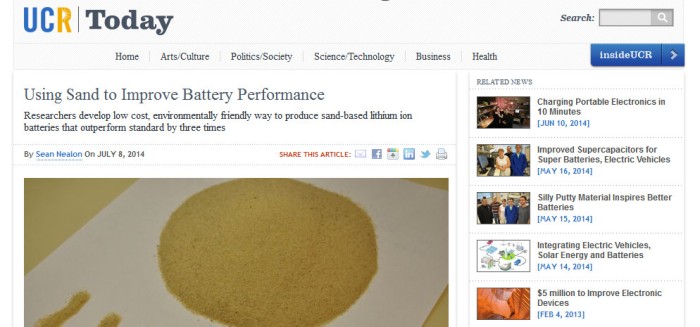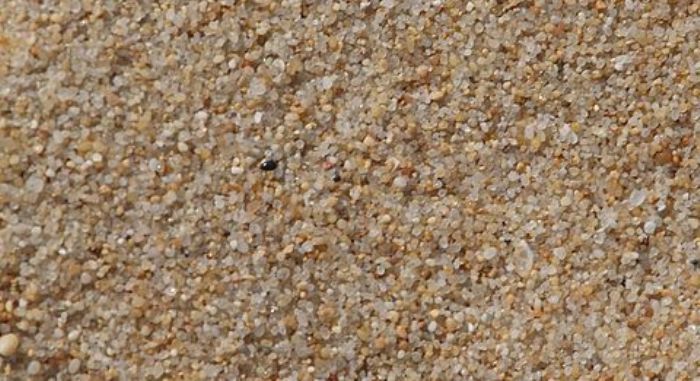Using Sand Can Mean Three Times Greater Battery Capacity
In a post a few weeks back we wrote about nanowire based and pomegranate inspired batteries that are expected to improve capacity and performance. This time, another welcome development in battery technology has been achieved with the help of a material often associated with abundance and innumerability: sand.
Researchers at the University of California, Riverside made a breakthrough after finding out that using silicon dioxide or quartz, a material that can be obtained from sand, can lead to greater battery capacity. The use of sand was the idea of Zachary Favors, a graduate student at the University of California, Riverside. He was curious about the possibility of using normal sand grains to produce battery anodes after he observed sand prominently made of quartz or silicon dioxide while he was on the beach of San Clemente, California.
Quartz or silicon dioxide has no value in battery production but silicon has. Having realized that sand can be a good source for silicon dioxide that can be later on processed to separate the silicon from oxygen, Favors went ahead and looked for places in the United States where sands have high quartz component levels. This took him to Cedar Creek Reservoir, on the eastern side of Dallas, the location where he took his sand samples. To pursue the research, Favors worked with UC Riverside professors Cengiz and Mihri Ozkan.
To emphasize the idea of this research, the use of sand here infers the use of sand to obtain silicon. Some fine processing and procedures were involved. The silicon extracted was to be used as a replacement for graphite in battery anode production.
Cropped Screenshot from Nature.com Scientific Reports (http://www.nature.com/srep/2014/140708/srep05623/fig_tab/srep05623_F1.html)
Deriving Silicon from Sand
To obtain silicon from sand, the sand samples were milled down to the nanometer scale. A series of purification procedures were then undertaken, changing the sand’s color from brown to white. The result was a dry substance that looked like confectioner’s sugar—powdery and soft. This powdery substance was then mixed with ground salt and magnesium. Next, heat was introduced to the (quartz + salt + magnesium) mixture. This process was undertaken to remove oxygen from silicon dioxide (the white powdery substance). Salt acts as a heat absorber while magnesium reacts with silicon dioxide to remove the oxygen from the compound. The result of the whole process is pure nano-silicon.
Cropped Screenshot from Nature.com Scientific Reports (http://www.nature.com/srep/2014/140708/srep05623/fig_tab/srep05623_F1.html)
Nano-Silicon
The nano-silicon obtained by the process described earlier turned out to be more than what the research team (Favors and professors Cengiz and Mihri Ozkan) expected. The silicon extraction process didn’t appear to be that rigorous and difficult. Even better, upon close inspection, they found out that the nano-silicon they produced exhibited a porous 3D silicon sponge like consistency. The porosity and consistency are believed to be the reason why nano-silicon does a great job in extending battery capacity, as they enable an energy density that is up to three times higher than what can be achieved with graphite.
Advantages and Challenges
With sand as the key ingredient, the most obvious advantage of this breakthrough is the lowering of battery costs. Quartz harvested from sand is definitely cheaper than the typical graphite used lithium-ion batteries. Some processing will have to be undertaken and the processes still have to be tweaked and optimized but it is estimated that, overall, the costs will be significantly lower than the overall cost of using graphite.
Another advantage of this breakthrough is the eco-friendly nature of the processes and the materials involved. Graphite or silicon dioxide is naturally occurring. The salt and magnesium used to process it are also naturally occurring and non-toxic.
It is worth noting, however, that nanoscale silicon degrades quickly. It’s important to be quick and efficient in handling it. Also, typically, nanoscale silicon is difficult to produce. This difficulty, though, has already been addressed by using quartz-rich sand and the processes Favors and the Ozkan team have come up with.

Screenshot of the UCR article on improving battery performance by using sand (http://ucrtoday.ucr.edu/23646)
As reported on UCR Today (a University of California Riverside newspaper), the research team led by the Ozkan professors are already preparing to produce larger amounts of nano-silicon from ordinary sand. They are also trying to produce nano-silicon based pouch-sized batteries that can be used in mobile phones and other personal electronic devices.
This research has been published on the Nature Scientific Reports journal entitled “Scalable Synthesis of Nano-Silicon from Beach Sand for Long Cycle Life Li-ion Batteries.” It is supported by Temiz Energy Technologies. The University of California Riverside Office of Technology Commercialization has already filed for the patents related to the research.
